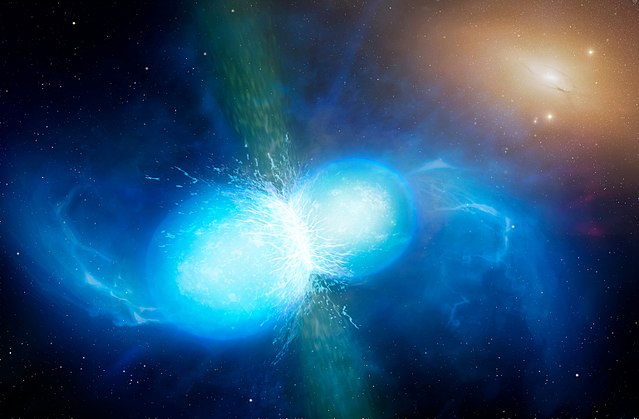A kilonova (also called a macronova) is a transient astronomical event that occurs in a compact binary system when two neutron stars or a neutron star and a black hole merge.[1] These mergers are thought to produce gamma-ray bursts and emit bright electromagnetic radiation, called "kilonovae", due to the radioactive decay of heavy r-process nuclei that are produced and ejected fairly isotropically during the merger process.[2][3] The measured high sphericity of the kilonova AT2017gfo at early epochs was deduced from the blackbody nature of its spectrum.[4][5]


History
The existence of thermal transient events from neutron star mergers was first introduced by Li & Paczyński in 1998.[1] The radioactive glow arising from the merger ejecta was originally called mini-supernova, as it is 1⁄10 to 1⁄100 the brightness of a typical supernova, the self-detonation of a massive star.[6] The term kilonova was later introduced by Metzger et al. in 2010[7] to characterize the peak brightness, which they showed reaches 1000 times that of a classical nova.
The first candidate kilonova to be found was detected as a short gamma-ray burst, GRB 130603B, by instruments on board the Swift Gamma-Ray Burst Explorer and KONUS/WIND spacecraft and then observed using the Hubble Space Telescope 9 and 30 days after burst.[8]

On October 16, 2017, the LIGO and Virgo collaborations announced the first simultaneous detections of gravitational waves (GW170817) and electromagnetic radiation (GRB 170817A and AT 2017gfo)[9] and demonstrated that the source was a binary neutron star merger.[10] This merger was followed by a short GRB (GRB 170817A) and a longer lasting transient visible for weeks in the optical and near-infrared electromagnetic spectrum (AT 2017gfo) located in a relatively nearby galaxy, NGC 4993.[11] Observations of AT 2017gfo confirmed that it was the first conclusive observation of a kilonova.[12] Spectral modelling of AT2017gfo identified the r-process elements strontium and yttrium, which conclusively ties the formation of heavy elements to neutron-star mergers.[13][14] Further modelling showed the ejected fireball of heavy elements was highly spherical in early epochs.[4][15] It has been suggested that "Thanks to this work, astronomers could use kilonovae as a standard candle to measure cosmic expansion. Since kilonovae explosions are spherical, astronomers could compare the apparent size of a supernova explosion with its actual size as seen by the gas motion, and thus measure the rate of cosmic expansion at different distances."[16]
Theory
The inspiral and merging of two compact objects are a strong source of gravitational waves (GW).[7] The basic model for thermal transients from neutron star mergers was introduced by Li-Xin Li and Bohdan Paczyński in 1998.[1] In their work, they suggested that the radioactive ejecta from a neutron star merger is a source for powering thermal transient emission, later dubbed kilonova.[17]
Observations

A first observational suggestion of a kilonova came in 2008 following the gamma-ray burst GRB 080503,[19] where a faint object appeared in optical light after one day and rapidly faded. However, other factors such as the lack of a galaxy and the detection of X-rays were not in agreement with the hypothesis of a kilonova. Another kilonova was suggested in 2013, in association with the short-duration gamma-ray burst GRB 130603B, where the faint infrared emission from the distant kilonova was detected using the Hubble Space Telescope.[8]
In October 2017, astronomers reported that observations of AT 2017gfo showed that it was the first secure case of a kilonova following a merger of two neutron stars.[12]

In October 2018, astronomers reported that GRB 150101B, a gamma-ray burst event detected in 2015, may be analogous to the historic GW170817. The similarities between the two events, in terms of gamma ray, optical and x-ray emissions, as well as to the nature of the associated host galaxies, are considered "striking", and this remarkable resemblance suggests the two separate and independent events may both be the result of the merger of neutron stars, and both may be a hitherto-unknown class of kilonova transients. Kilonova events, therefore, may be more diverse and common in the universe than previously understood, according to the researchers.[20][21][22][23] In retrospect, GRB 160821B, a gamma-ray burst detected in August 2016, is now believed to also have been due to a kilonova, by its resemblance of its data to AT2017gfo.[24]
A kilonova was also thought to have caused the long gamma-ray burst GRB 211211A, discovered in December 2021 by Swift’s Burst Alert Telescope (BAT) and the Fermi Gamma-ray Burst Monitor (GBM).[25][26] These discoveries challenge the formerly prevailing theory that long GRBs exclusively come from supernovae, the end-of-life explosions of massive stars.[27] GRB 211211A lasted 51s;[28][29] GRB 191019A (2019)[30] and GRB 230307A (2023),[31][32] with durations of around 64s and 35s respectively, have been also argued to belong to this class of long GBRs from neutron star mergers.[33]
In 2023, GRB 230307A was observed and associated with tellurium and lanthanides.[34]
See also
References
Wikiwand in your browser!
Seamless Wikipedia browsing. On steroids.
Every time you click a link to Wikipedia, Wiktionary or Wikiquote in your browser's search results, it will show the modern Wikiwand interface.
Wikiwand extension is a five stars, simple, with minimum permission required to keep your browsing private, safe and transparent.
